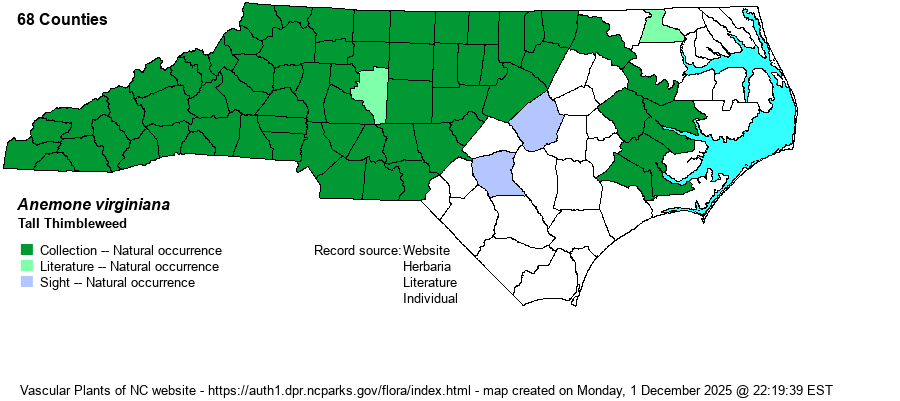| Author | L. | |
| Distribution | Occurs throughout the Mountains and Piedmont; ranges eastward in the Coastal Plain into the northern 50-60% of the province, but absent from the Sandhills proper and the southern portions. Also appears to be absent from the northeastern Coastal Plain, with records east only to Martin, Beaufort, and Craven counties.
This is a very widespread species of southern Canada and the Eastern states, ranging south to central portions of GA and MS and west to OK. It has been recorded from nearly all counties over most of the states in the range. | |
| Abundance | Frequent to common across all of the Mountains and Piedmont, though it does not grow in extensive patches/colonies like other members of the genus. In the Coastal Plain, it is mainly limited to rich sites along the Roanoke River, and southward to several other east-central counties there; uncommon near the river but rare elsewhere. | |
| Habitat | This is a species of mesic to rich soils, more often where circumneutral, but it normally does not grow in deep shade of forest interiors. It prefers open woods, woodland margins, glades, and other semi-forested sites. Some sites are even rather dry, and it does not normally grow in bottomlands or other wetland habitats. | |
| Phenology | Blooms from May to July, and fruits soon after flowering. | |
| Identification | This species is very different from the other five Anemone species in NC. It has a stout and rather tall stem, growing to about 2-2.5 feet tall. It has both basal and cauline (stem) leaves; each set is fairly deeply dissected, into 3-5 segments, with the margins quite serrated; each leaf has a petiole of 1-2 inches. There is just one whorl of stem leaves (3 of them) midway up the stem, but there may be a few very small leaves farther up the stem. At the top of the stem, typically 1 foot above the main whorl of leaves, is the solitary flower -- 5 dull white or slightly greenish-tinted white sepals that are about 1-1.2 inches across when fully open. Only a few weeks after flowering there is a large thimble-like "cone" fruit formed, typically just over 1 inch high. You may have difficulty identifying this plant if just the basal leaves are seen, as there are many members of the buttercup family with heavily toothed and divided leaves. But, once the very straight and mostly naked stem is seen, all doubt is erased. This is a widespread species over a given county, but it does not grow in large colonies; instead, it is very scattered over a region, though a handful can certainly grow together. It is difficult to target where to look for it, as it does not grow normally inside Basic Mesic Forests or Rich Cove Forests, but can occur along their edges, or along wide trail margins. | |
| Taxonomic Comments | There are several varieties of the species; the only one in NC is the nominate one -- A. virginiana var. virginiana.
| |
| Other Common Name(s) | Tall Anemone, Thimbleweed | |
| State Rank | S5 | |
| Global Rank | G5 | |
| State Status | | |
| US Status | | |
| USACE-agcp | FACU link |
| USACE-emp | FACU link |

